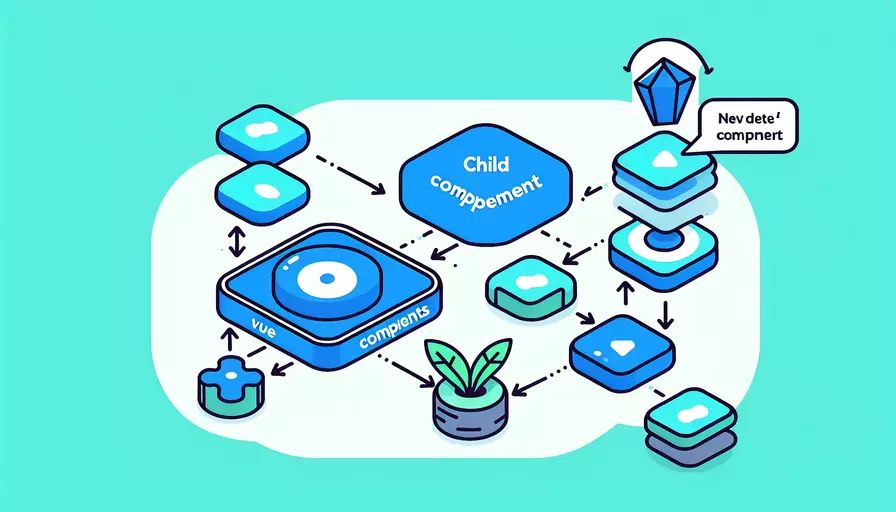
Vue实例对象可以通过以下几种方式获取子组件:1、使用ref属性,2、使用$children属性,3、使用$parent属性。其中,使用ref属性是最常用且推荐的方式。它允许我们在子组件实例上添加一个引用标识符,然后在父组件中通过这个标识符直接访问子组件实例。
一、使用ref属性
在Vue中,可以通过在子组件上添加ref属性来获取子组件实例。以下是具体步骤:
- 在子组件上添加
ref属性。 - 在父组件中通过
this.$refs访问子组件实例。
示例代码如下:
<!-- 父组件模板 -->
<template>
<div>
<child-component ref="childRef"></child-component>
<button @click="accessChild">访问子组件</button>
</div>
</template>
<script>
export default {
methods: {
accessChild() {
// 通过 this.$refs.childRef 访问子组件实例
this.$refs.childRef.someChildMethod();
}
}
}
</script>
<!-- 子组件模板 -->
<template>
<div>
<!-- 子组件的内容 -->
</div>
</template>
<script>
export default {
methods: {
someChildMethod() {
console.log('子组件方法被调用');
}
}
}
</script>
在这个示例中,父组件通过this.$refs.childRef获取子组件实例,并调用子组件的方法someChildMethod。
二、使用$children属性
另一种方式是使用$children属性。$children是一个包含当前实例所有直接子组件实例的数组。注意,它只包含直接子组件,不包括嵌套的子组件。
<!-- 父组件模板 -->
<template>
<div>
<child-component></child-component>
<button @click="accessChild">访问子组件</button>
</div>
</template>
<script>
export default {
methods: {
accessChild() {
// 通过 this.$children 获取子组件实例
this.$children[0].someChildMethod();
}
}
}
</script>
<!-- 子组件模板 -->
<template>
<div>
<!-- 子组件的内容 -->
</div>
</template>
<script>
export default {
methods: {
someChildMethod() {
console.log('子组件方法被调用');
}
}
}
</script>
在这个示例中,父组件通过this.$children[0]获取第一个子组件实例,并调用子组件的方法someChildMethod。
三、使用$parent属性
在某些情况下,子组件也可以通过$parent属性访问父组件实例。$parent指向当前实例的父实例。
<!-- 父组件模板 -->
<template>
<div>
<child-component></child-component>
</div>
</template>
<script>
export default {
methods: {
parentMethod() {
console.log('父组件方法被调用');
}
}
}
</script>
<!-- 子组件模板 -->
<template>
<div>
<button @click="accessParent">访问父组件</button>
</div>
</template>
<script>
export default {
methods: {
accessParent() {
// 通过 this.$parent 访问父组件实例
this.$parent.parentMethod();
}
}
}
</script>
在这个示例中,子组件通过this.$parent访问父组件实例,并调用父组件的方法parentMethod。
四、其他方式
除了上述三种方式,还可以使用一些其他方式获取子组件,例如:
- 通过事件总线:可以在父组件和子组件之间使用事件总线来传递消息,从而实现访问子组件。
- Vuex状态管理:使用Vuex来管理应用的状态,通过共享状态和方法实现组件间的访问和通信。
总结起来,推荐使用ref属性来获取子组件实例,因为它更直观且容易管理。其他方法如$children和$parent在某些特定场景下也有其应用价值,但要注意其局限性和适用范围。
在使用这些方法时,建议遵循以下几点:
- 避免过度依赖组件实例直接访问:尽量通过props和事件进行父子组件通信,保持组件的松耦合。
- 确保组件生命周期:在获取子组件实例时,确保子组件已经挂载完成,避免访问未初始化的组件。
- 命名规范:使用
ref时,确保引用标识符具有描述性,避免命名冲突。
通过上述方法和建议,可以更好地管理和访问Vue实例对象中的子组件,从而实现更高效的组件间通信和操作。
相关问答FAQs:
1. 如何在Vue实例中获取子组件?
在Vue中,可以通过$children属性来获取子组件。$children是一个数组,包含了当前Vue实例下的所有直接子组件。你可以通过遍历$children来访问和操作这些子组件。
以下是一个示例代码:
// 父组件
<template>
<div>
<child-component ref="child"></child-component>
</div>
</template>
<script>
import ChildComponent from './ChildComponent.vue';
export default {
components: {
ChildComponent
},
mounted() {
// 获取子组件实例
const childComponent = this.$refs.child;
// 在这里你可以访问和操作子组件的属性和方法
console.log(childComponent);
}
}
</script>
在上面的代码中,父组件中引入了一个名为ChildComponent的子组件,并给它设置了一个ref属性为child。然后在mounted生命周期钩子中,通过this.$refs.child来获取子组件实例,并将其赋值给childComponent变量。你可以在childComponent中访问和操作子组件的属性和方法。
2. 如何在子组件中与父组件进行通信?
在Vue中,父组件与子组件之间的通信可以通过Props和Events来实现。
- Props:父组件通过Props属性向子组件传递数据,子组件通过props选项接收父组件传递的数据。这样子组件就可以使用父组件传递的数据了。
以下是一个示例代码:
// 父组件
<template>
<div>
<child-component :message="message"></child-component>
</div>
</template>
<script>
import ChildComponent from './ChildComponent.vue';
export default {
components: {
ChildComponent
},
data() {
return {
message: 'Hello from parent component!'
};
}
}
</script>
// 子组件
<template>
<div>
<p>{{ message }}</p>
</div>
</template>
<script>
export default {
props: ['message']
}
</script>
在上面的代码中,父组件通过:message将message属性的值传递给子组件。子组件通过props选项接收父组件传递的数据,并在模板中使用。
- Events:子组件通过
$emit方法触发一个自定义事件,父组件通过v-on监听该事件,并在触发时执行相应的方法。
以下是一个示例代码:
// 父组件
<template>
<div>
<child-component @custom-event="handleCustomEvent"></child-component>
</div>
</template>
<script>
import ChildComponent from './ChildComponent.vue';
export default {
components: {
ChildComponent
},
methods: {
handleCustomEvent() {
// 在这里执行相应的操作
}
}
}
</script>
// 子组件
<template>
<div>
<button @click="triggerCustomEvent">Click me</button>
</div>
</template>
<script>
export default {
methods: {
triggerCustomEvent() {
this.$emit('custom-event');
}
}
}
</script>
在上面的代码中,子组件中的按钮点击事件触发了一个自定义事件custom-event,父组件通过@custom-event监听该事件,并在触发时执行handleCustomEvent方法。
3. 如何在子组件中调用父组件的方法?
在Vue中,可以通过$emit方法来调用父组件的方法。
以下是一个示例代码:
// 父组件
<template>
<div>
<child-component @call-parent-method="handleCallParentMethod"></child-component>
</div>
</template>
<script>
import ChildComponent from './ChildComponent.vue';
export default {
components: {
ChildComponent
},
methods: {
handleCallParentMethod() {
// 在这里执行父组件的方法
}
}
}
</script>
// 子组件
<template>
<div>
<button @click="callParentMethod">Call parent method</button>
</div>
</template>
<script>
export default {
methods: {
callParentMethod() {
this.$emit('call-parent-method');
}
}
}
</script>
在上面的代码中,子组件中的按钮点击事件触发了一个自定义事件call-parent-method,父组件通过@call-parent-method监听该事件,并在触发时执行handleCallParentMethod方法。这样就实现了在子组件中调用父组件的方法。
文章标题:vue实例对象如何获取子组件,发布者:不及物动词,转载请注明出处:https://worktile.com/kb/p/3683509

 微信扫一扫
微信扫一扫  支付宝扫一扫
支付宝扫一扫 